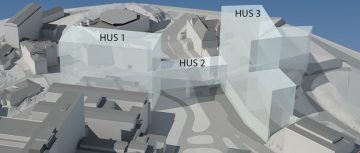CAMPUS MEDICINAREBERGET. A program review of parts of Sahlgrenska Life, Buildings 2 and 3, in which the University will be a primary tenant, is currently underway. Simultaneously, Region Västra Götaland (VGR, the county council) is continuing work on Building 1, and the City of Gothenburg (the municipality) is taking new steps towards the adoption of the detailed development plan.
Work on the program overview for Buildings 2 and 3 is led by a steering group under the University’s management, and chaired by the Dean. Heads of all the departments and the Vice Deans of Education and Infrastructure take part. Doctoral and undergraduate students are also represented and, in addition, there are a number of reference groups. Along with project managers from the University’s Strategic Project Management unit and a program architect, the departments are now producing a premises list, based on their future needs.
The Sahlgrenska Academy departments that are planning for new premises in Buildings 2 and 3 are the Institutes of Health and Care Sciences, Odontology, Clinical Sciences and Medicine. For the University’s part, the Biomedical Library is also included. The plan is now for the Institute of Odontology, previously a separate part of Sahlgrenska Life, to be housed in Building 3.
There are also joint reference groups. One group for training facilities has already begun work. Later on, reference groups will be added for translational research clusters and a skills center.
During the latter part of the program review, an intensive period awaits the architects. Their task is then to find solutions in the buildings for the incoming activities. Thereafter, the “system phase” will start, with the aim of producing a practical proposal for a functional building. This work is expected to take approximately a year, with completion in the fall of 2022.
Finance Committee for dialogue and analysis of premises costs
A finance committee is linked to the steering group. This committee works on in-depth analyses of what the investment will mean for the Faculty’s finances in the long term.
Still, at the current project stage, only indicative costs of premises are available. Lease agreements will be signed with the property owner only after completion of the system phase. This is anticipated to take place in the fall of 2022.
Besides rent exclusive of heating and hot water, costs of premises also include operating costs and depreciation of furnishings and equipment. Even if Sahlgrenska Academy were to remain in its current premises, costs would be expected to rise owing, for instance, to rent increases and upcoming renovations. These future premise-cost predictions are compared with the premises-cost forecast for Sahlgrenska Life. The term “cost neutrality” therefore does not mean that, after the move into Sahlgrenska Life, the premises must cost the same as they do at present but, rather, the same as forecast premises costs if no move had taken place.

For the institutes to have a solid basis for discussion, they have received interim forecasts that shed light on how much the costs of the areas they wish to occupy in Buildings 2 and 3 deviate from cost neutrality. An institution with a large deviation thus receives an opportunity to review its plan. At this stage, modifications are still feasible.
Our total premises requirements in Buildings 2 and 3 are currently estimated at 10,500 square meters, against some 11,600 square meters in the premises we plan to leave.
Complex project with major need for coordination
For VGR’s activities in Sahlgrenska Life’s Buildings 1, 2 and 3, program work similar to that being done by the University for Buildings 2 and 3 is being carried out by VGR. Although the University will not be a primary tenant in Building 1, there is keen interest. Building 1 is being constructed for laboratory medicine, an area of huge importance to Sahlgrenska Academy’s researchers. There is already extensive collaboration with Sahlgrenska University Hospital. Representatives of the Academy are therefore participating in the Building 1 program work, just as the Hospital’s representatives are taking part in ours.
Ahead of the next system phase, there will be marked needs for coordination among the various parts of Sahlgrenska Life. The project owners will shortly decide on an organization for coordination at various levels.
City of Gothenburg takes another step towards detailed development plan
A decision to adopt the detailed plan is required for the implementation of Sahlgrenska Life. On March 16th, the City of Gothenburg’s Planning and Building Committee decided to proceed with the detailed planning work for a review. This is the phase in which residents in the area and consultation bodies can submit their views.
The review period runs between March 24th and April 27th. Comments received are then summarized in a review statement. After any minor adjustments, the Planning and Building Committee can then adopt the draft plan. Subsequently, those who are affected by the detailed plan can appeal. The final step in the remaining process is for the City Council to adopt the detailed development plan.
BY: HELEN EASTERLING











